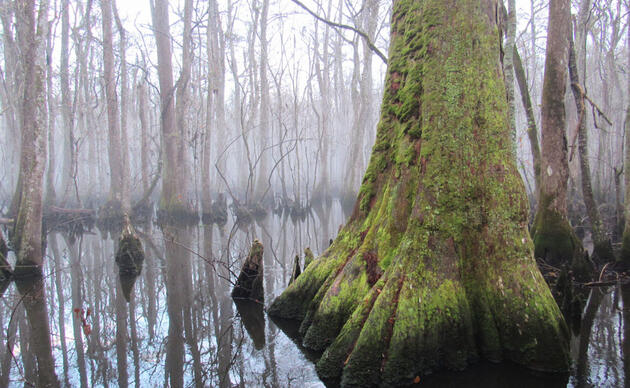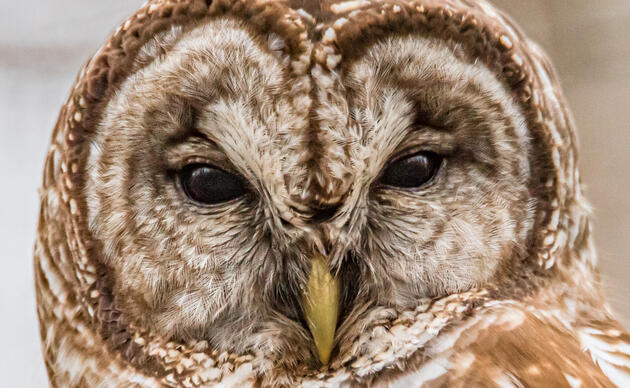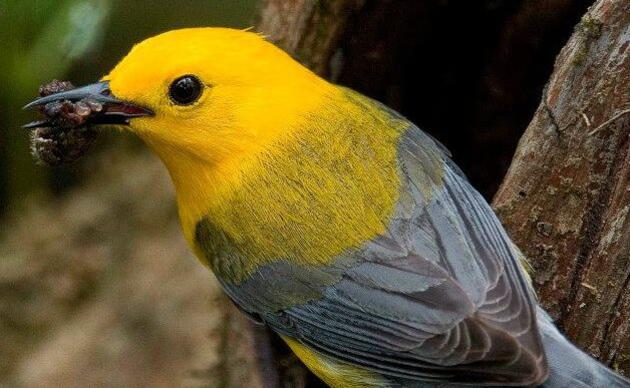In June 2025, Santee Cooper – a state-owned electric utility – filed an application to update a power line right-of-way through the Audubon Center and Sanctuary at Francis Beidler Forest. Since the 1940s, this right-of-way has existed not far from the visitor center and the 1.75-mile, publicly accessible boardwalk. But what Santee Cooper is now proposing goes far beyond routine maintenance – it threatens one of the most irreplaceable natural treasures in the world.
To construct the updated line for the Wassamassaw to Indian Field 230 kV transmission project, Santee Cooper is proposing to clear their entire right-of-way, including a 25-foot-wide strip over a 7,000-foot span that would result in the removal of 632 identified trees – including areas that have not been cleared in decades, if ever. Even more concerning, the utility plans to remove "danger trees" up to 100 additional feet on either side of the right-of-way, potentially clearing or disturbing a total 325-foot-wide swath that would bring the felling of centuries-old trees to within just a few hundred feet of Beidler's iconic public boardwalk – and in some places, could be visible from the scenic boardwalk itself.
A Living Archive Under Threat
What makes this proposal so concerning is what’s at stake. Designated as a Ramsar Wetland of International Importance and an Important Bird Area, the 18,000-acre Francis Beidler Forest draws thousands of visitors each year – from families seeking a unique outdoor experience to biologists and photographers exploring one of the last ancient ecosystems in the Southeast. It also provides vital benefits to surrounding communities: storing carbon and floodwater and filtering storm and drinking water before it flows downstream.
The towering trees here have stood for more than 1,500 years – bearing witness to generations of the Edisto Natchez-Kusso Tribe that still inhabit this part of their ancestral lands, as enslaved people sought freedom in the dense swamps, and as Carolina Parakeets called from their branches and Ivory-billed Woodpeckers drummed against their bark – both species now extinct due to habitat destruction.
Beidler also provides critical habitat for more than 180 bird species – including the Prothonotary Warbler, a cavity-nesting species dependent on forested wetlands and currently listed as threatened in South Carolina – as well as other state-listed species like the Spotted Turtle, which is known to occur in areas that would be affected by the proposed project.
Even Beidler’s synchronous fireflies – a rare and increasingly vulnerable natural phenomenon – could be harmed. Audubon’s popular Firefly Nights events, which consistently sell out, may be at risk if tree clearing proceeds as planned.
Fighting for Alternatives
Audubon respects Santee Cooper's longstanding right-of-way and acknowledges the need for reliable energy infrastructure to serve South Carolina's growing population. We support grid modernization that improves reliability, lowers costs, and enables the transition to renewable energy. But Beidler Forest – home to threatened species and active research – is one of the worst possible places for this kind of expansion.
The right-of-way through Beidler Forest was established in the 1940s, predating important environmental protections and the clearing of much of the then-remaining old-growth forest in our state. We are deeply concerned about the potential for irreparable damage to this one-of-a-kind resource.
Growth in this region – and across South Carolina – is rapid, intense, and showing no signs of slowing. This is a precedent-setting case. As we upgrade and expand our energy grid, we must also safeguard the state's most sensitive ecological and cultural landscapes. That means avoiding old-growth forests, vulnerable habitats, and active conservation and research sites whenever possible.
As such, Audubon has partnered with the Southern Environmental Law Center to officially intervene in proceedings at the South Carolina Public Service Commission and has engaged with the Department of Environmental Services to advocate for alternatives that avoid damaging the forest or ensure that the process is completed in as environmentally sensitive a way as possible.
We're urging Santee Cooper to take every necessary precaution to ensure this project is planned and implemented in a way that honors the integrity and ensures the preservation of one of the state's most irreplaceable ecological treasures, beginning with a transparent exploration of all alternative routes.
How You Can Help
Before the project can proceed, Santee Cooper’s transmission line proposal must be approved by the Public Service Commission, which is accepting public comments in advance of its Aug. 26 hearing.
Click here to submit your comment and make your voice heard.
Interested in getting the latest news, updates, and action alerts about Audubon and Beidler Forest? Sign up here today.
Beidler Forest in the News
-
"'A devastating loss’: Santee Cooper proposes new transmission line through ancient SC forest"
The Francis Beidler Forest is one of SC's oldest untouched forests. The state-owned Santee Cooper utility wants to run a new power line through the area.
Read the article | Post and Courier, August 2025
-
Editorial: "Beidler Forest should be enhanced, not weakened, as growth arrives"
Santee Cooper's plans to upgrade a transmission line that runs for a mile through the Audubon Beidler Forest deserve scrutiny to lessen harm to bird sanctuary.
Read the article |Post and Courier, August 2025 -
Commentary: "Ancient forest, modern choice: Protecting the future of Audubon’s Beidler Sanctuary"
We need to strengthen SC's power grid but leaders protecting and managing Beidler Forest recognize infrastructure, conservation need not be mutually exclusive.
Read the article | Post and Courier, July 2025





